
|
|
|
|
 |
|
Home Site Search Contact Us Subscribe
|
|
|
|
Metaphors for Motion: University of Connecticut Farmington Musculoskeletal Institute by AHSC Architects
Farmington, Connecticut: A building articulates its purpose with muscle and grace. by James W. Tilghman, AIA June 2, 2004 Editor’s
note: The Musculoskeletal Institute/Medical
Arts Research Building on the University of Connecticut
Farmington campus, designed by Tarrytown, New York-based AHSC Architects, will
be a four-story, 99,000-square-foot freestanding building on a partially
sloping wooded site immediately adjacent an existing administrative services
building (ASB). When completed this winter, the almost $20 million building
will house a mix of clinical and research components in addition to an
ambulatory surgery center. It
is one of the first projects to be realized in a new master plan for the
162-acre campus. The site lies on a potential pedestrian route linking the
upper and lower campus zones of the UCONN Health Center. The challenge posed by the site is the location – a bit
tucked away from public view as seen from the main approach to the campus with
the existing ASB building in the foreground. The design needed to “reach out”
in a fairly audacious way to the view corridor from the main road if the new
building was going to have sufficient presence as an anchoring element for the
lower campus. The project received a 2003 AIA Design Award for Unbuilt
Projects. The expressive design solution draws from the building’s
program by examining certain metaphors related to the research activity housed
within, as AHSC
Architects Director of Design and the UCONN MSI project designer James W. Tilghman,
AIA, explains: Design
Process
From the outset, we
were presented with aggressive budgetary and scheduling objectives – $200 per square foot and a blindingly fast
20-month design/construction Schedule. Even with these constraints, the
AHSC team felt confident that design excellence could emerge from the design
process – that the budget and schedule objectives need not preclude design
excellence. We reached a
destination in this project that was unforeseen at the outset, but that emerged
in a clearly defined series of conceptual steps both on a campus scale and at
the scale of the design language for the building. This sense of discovery and
unfolding of the language of the building made the design process truly
special. Design
elements
We knew that there
was an opportunity, and a desire, for this building to make a clear and
dramatic gesture toward the campus entry point. There were also opportunities
in the design process to make several objectives “transparent” to one another –
that is, where a single design move could satisfy multiple objectives at once. The basic building
geometry is an example of this. The 21-degree angle of the building emerged
from looking at the “tipping point’’ of campus geometry – where the optimum
angle was for making a critical connection to pedestrian routes on the uphill
side that would connect through the new building to the lower campus areas. In
doing so, the dramatic acute angled corner of the building pushes outward
toward the entry approach, while increasing natural light in the laboratory
spaces located on the west side of the building. Design
language
Satisfying
programmatic requirements, adjacencies, entry conditions, and circulation
strategies is clearly paramount in a building of this complexity – but we asked
ourselves what could be done to truly enhance the architectural presence and
the quality of experience in this building? How might we bring some broader
meaning to the language of this building given its mission as a Musculoskeletal
Institute? Going back to the design process we knew that we would have
to identify opportunities for expressive potential right from the start: the
initial planning and site concepts would have to clearly anticipate and support
future design refinement. A significant opportunity clearly presented itself in
the lobby and entry face of the building. This was where we could bring
forward, in a thematic way, some insight into what really goes on in this
unique facility – and on a scale that could speak to the whole campus. We developed a
strategy very early on that the building, while trapezoidal in plan form, could
and should be a fairly simple box as it moved south into the hillside site.
This supported the idea that the first 25 feet into the plan at the north entry
side could be where a truly special environment could be created. The rear wall of the
lobby – 55 feet high and 120 feet long – stood there like a tabula rasa
ready for something really dynamic to take place. The projecting portico
element, 59 feet above the ground and cantilevered 20 feet over the entry, also
represented a chance for structural expression. The portico effectively
captures the natural environment around it – inviting the outside in toward the
wetland area, and creating a kind of large outdoor room at the entry. The
Wall-In-Motion and The Armature
The final major
elements to emerge from the design process we call “ the Armature” and the
“wall-in-motion,” which are linked thematically, but examine what could be
called “musculoskeletality” in different ways. We realized that the
rear lobby wall could be about “motion” – described in a series of folded wall
planes with sequential geometric relationships. The concept had considerable
expressive potential, and the theme of motion had enormous relevance to the
activity housed within. It was a very legible concept. This was a particularly
exciting moment in the design process. If the wall-in-motion
represents a series of moments, the armature element stands in contrast as a
single moment – a stop frame so to speak. It is intended to resonate on many
levels with the theme of “musculoskeletality.” It clearly is an entry piece,
and ultimately an icon for the place and the institution. The two elements are
interdependent in a sense: they reinforce one another thematically, but add
different dimensions to the experiencing this new environment. Details
The ultimate
objective for the building is to be engaging as you move through and around it
– doing everything from performing research to performing procedures in
operating rooms. To do this, decisions about materiality, color and lighting
all need to support the “spirit” of the new environment, and to have a palpable
connection back to first principles. While the building is
in a campus setting, it is essentially a “green field” or “green hill” site. We
worked hard to create a very real connection to the landscape in both the basic
orientation of the building, but also in terms of material, detail, and color
selections. The lobby floor is to be an acid-washed concrete, which is a highly
variegated and somewhat “earthy” material that will resonate with the tree
canopy and wetlands area visible through the lobby curtain wall. The pattern of
jointing is an extension of the geometry of the wall-in-motion. As far as the
interior finish concrete specification goes, we briefly dreamed about using
indigenous site gravel and materials in the actual mixture. The closest we come
to this is at the reception desk – the top surface is a laminated glass
product, lighted from below, with what could be described as an “organic”
interlayer. The effect is somewhat mysterious –dense layers that appear to be
made up of many kinds of organic materials taken directly from the site. The detailing of the
stair railings and other hardware references back to the geometry of the
Armature and the wall-in-motion. All of these elements taken together are a
“family of forms” that constantly engage visitors and staff at different
scales. Image:
A Center for The “Performing Medical Arts”
From the standpoint
of image, we were interested in extending the envelope of expression for a
research and clinical facility – moving away, within the budgetary limits, from
a preconception of what such facilities are expected to look like or should
look like. For both the client
and the AHSC team, this project represents an opportunity to take a fresh look
at the architecture of the integrated research/clinical building type. What I
think we’ve done particularly well is to reduce the theme of
“musculoskeletality” to its essence in a dynamic and compelling way – a legible
way. Finally… Looking back on the
design process for this building, I note that most good concepts that endure in
the process are there right from the start. We were very fortunate that the
very earliest strategic decisions created the right opportunities for the
development of the design language of the project. The
programmatic mix is, in effect, a microcosm of the entire Health Center brought
into very close proximity. Departments and disciplines to be housed in the
facility will include a Diagnostic Imaging suite; Rehabilitation and Sports
Medicine facilities; clinical offices for Orthopaedics, Osteoporosis/bone density,
and Rheumatology; the Musculoskeletal Institute Research Laboratories and
offices; and an Ambulatory Surgery Center. A café accessible off the main lobby
will provide a gathering place for staff and visitors from the immediate campus
area. -- James W. Tilghman,
AIA Project credits: Architect: AHSC Architects, P.C. Project Team: John M. Kenney, AIA (Senior
Principal-in-Charge), James R. Fair, AIA (Sr. Principal Project Manager), James
W. Tilghman, AIA (Director of Design, Project Designer), Kimberly Weller, AIA
(Planning Principal), Kevin Rohane, AIA (Planning Principal-Laboratory), Neil
Spanier, AIA (Technical Principal), Larry Costello, Pedro Abreu, Greg Ruoti,
Greg Bennett, AIA, Alex Hidalgo, Mahmoud Rafeh (Design/Production Team) Project Manager: Hammes Company General Contractor: FIP Construction Consultants: Structural: Purcell Associates MEP: Van Zelm, Heywood and Shadford Inc. Civil: Macchi Engineers AHSC
is
comprised of two firms: AHSC Architects and AHSC McLellan Copenhagen, a
consulting firm serving the scientific community. The two firms, having common
ownership, work together seamlessly when needed to provide full service
laboratory design from programming through construction. Founded in 1981, AHSC
has grown to be one of the leading health care design firms in the United
States, and has also established a strong reputation for research, education,
and elder care facilities design. AHSC McLellan Copenhagen is a
consulting/design firm that provides programming, planning, and design serving
academic, governmental, biotech and pharmaceutical organizations; nationally
and internationally. James W. Tilghman, AIA, is Director of Design for AHSC. Prior to
joining the firm, he held senior design positions at Skidmore, Owings &
Merrill, New York, Pei Cobb Freed & Partners, and Foster Associates in
London, England. |
(click on pictures to enlarge)  (dboxstudio) View from northeast parking/pedestrian approach; "wall-in-motion is visible behind the lobby curtain wall. (dboxstudio) Northwest view (AHSC) North elevation with Armature element (AHSC) Lobby concept section showing relationship to wetlands areas and outdoor room concept.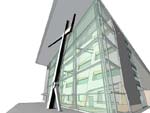 (AHSC) The Armature will be white painted steel with stainless steel cable and joint details.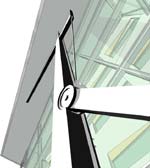 (AHSC) A closer view of the Armature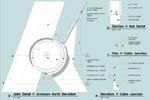 (AHSC) Armature details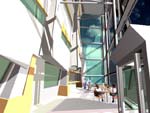 (AHSC) Lobby café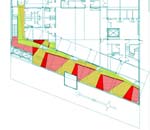 (AHSC) The lobby floor pattern will be acid washed concrete in a four-tone scheme.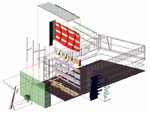 (AHSC) Exploded axonometric of lobby building elements, including wall-in-motion, armature, and curtain wall. (AHSC) Wall-in-motion elevation (AHSC) Concept sketch for the wall-in-motion (AHSC) Concept sketches-wall in motion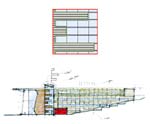 (AHSC) West elevation concept sketch and detail (AHSC) West elevation rendered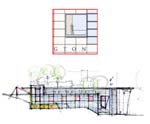 (AHSC) East elevation concept sketch and detail East elevation rendered East elevation rendered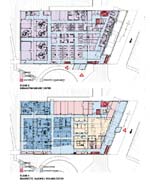 (AHSC) Plans: 1st and 2nd floors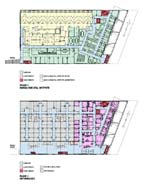 (AHSC) Plans: 3rd and 4th floors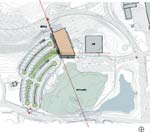 (AHSC) Site plan with existing Administrative Services Building and parking areas; bridge to upper campus at south elevation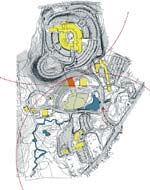 (AHSC) UCONN Health Center campus plan with Musculoskeletal Institute sited relative to campus geometries |
© 2004 ArchNewsNow.com